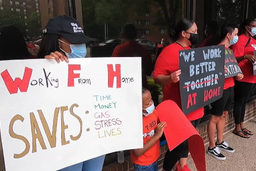In These Times started running “Health & Science” in January 2006. Below are three updates.
Gag me with a campaign
Merck’s force-it-down-consumers’-throats-campaign for Gardasil proved a powerful emetic. The new vaccine protects against two of the HPV strains that cause 70 percent of cervical cancers, but consumers gagged on making vaccination mandatory for all pre-teen girls. Exposure of short drug trials and long money trails forced Merck to kill its campaign to make middle school entry contingent on vaccination.
Problems with process and tactics go deeper. According to FDA guidelines, its advisory committee members are “qualified experts with minimal conflicts of interest … [who] provide FDA with independent advice.” But at least two members of the FDA panel that approved Gardasil had been Merck executives: Merck research director, Dr. John Boslego, ended his decade-long tenure with the company only two months before his FDA committee found Gardasil safe and effective. Another member, Alan Shaw, had represented Merck as late as May 2005 when he presented a paper at the 4th International Conference on Cervical Cancer on the HPV. The FDA granted both men waivers, and found no disqualifying conflicts of interest.
Members of Women in Government, a bi-partisan group of former and current legislators, also pushed the ethical envelope. At its annual conference in January, WIG endorsed vaccination, but failed to inform all members that it would push legislation making Gardasil mandatory, or that WIG took Merck funding.
Maine legislator Andrea Boland sat in on a select planning session at the conference where organizers said WIG would hold off on setting the program until we “see what the sponsors want.”
Her fellow Maine legislator, Marilyn Canavan, resigned from WIG after learning that it got Merck money. “The point is not that the vaccine is bad, but that the public agenda has all been company-driven,” she said.
Superbugs: collateral damage
A new superbug – a rare strain of antibiotic-resistant bacteria – is infecting hundreds of wounded Iraq and Afghanistan vets. At first, the administration blamed the acinetobacter baumannii outbreak on something in Iraq – the soil, the insurgents.
It soon emerged that wherever the bacteria’s origins, “the Pentagon had accidentally invented a machine for accelerating bacterial evolution and was airlifting the pathogens halfway around the world,” writes Steve Silberman in a brilliant article for Wired. Soldiers carried the superbug – loaded with the most genetic upgrades ever found in a single organism – from battlefield hospitals to Walter Reed and VA and civilian facilities across the United States.
While some U.S. medical efforts in Iraq were heroic, others, gave lie to “support our troops” rhetoric. At Ibn Sina Hospital in the Green Zone, the first stop for many wounded Americans, “rainwater dripped into operating rooms and supply closets, and pigeons roosted in the ventilation system,” Silberman wrote. “Clean sheets and scrubs were scarce … because the civilian laundry contractor was apparently selling them on the black market.”
Battlefield medicine, which relies on routinely dispensing multiple antibiotics in hopes that one will work, unwittingly promotes antibiotic resistance. As the March 2006 column, “Are Hospitals Hazardous to Your Health?”, noted, hospitals, filled with weakened patients and open wounds, are breeding grounds for emerging superbugs. Now, collateral damage from Bush’s wars is riding home with the wounded and adding to that already dire threat.
The Grey Lady is glowing
In December 2006, H&S looked at a lung cancer study, noting that the benefits of early diagnosis with CT scans should be weighed against the risk of the radiation. That study and an article on it by New York Times health reporter Gina Kolata ignored the danger of exposing CT scan patients to 500 times more radiation than a conventional chest X-ray.
A new study in the Journal of the American Medical Association shifted the balance, concluding that lung cancer screening with CT scans “does not appear to save lives and exposes people to serious risks of injury and even death from needless surgery,” Kolata now writes in the March 7 New York Times. Again, the risks she reports did not include radiation exposure.
Kolata seems not to recognize that while radiation can treat and detect cancer, it can also cause it. She has written more than a dozen articles in the last five years mentioning radiation; almost all as a treatment. A few articles noted that radiation for prostate cancer can cause impotence or incontinence.
In one 2002 article, she noted, “Some doctors have worried that the radiation treatments usually given after a lumpectomy may cause cancers themselves.” But she immediately counters with the chief of breast surgery at Sloan-Kettering, who cites two studies that “put that concern to rest.”
The next year Kolata quoted another expert who finds some evidence that “low-level radiation seems to make cells hardier.” Glow lady glow.

I hope you found this article important. Before you leave, I want to ask you to consider supporting our work with a donation. In These Times needs readers like you to help sustain our mission. We don’t depend on—or want—corporate advertising or deep-pocketed billionaires to fund our journalism. We’re supported by you, the reader, so we can focus on covering the issues that matter most to the progressive movement without fear or compromise.
Our work isn’t hidden behind a paywall because of people like you who support our journalism. We want to keep it that way. If you value the work we do and the movements we cover, please consider donating to In These Times.








